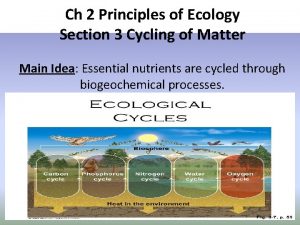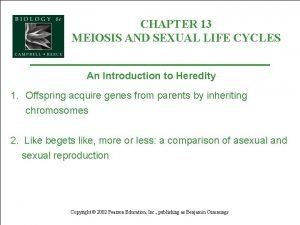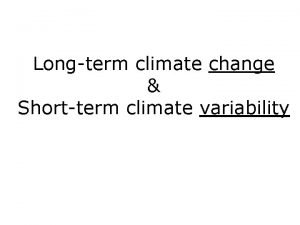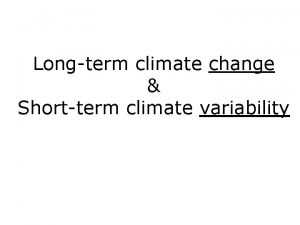CLIMATE CYCLES Chapter 14 Lesson 2 Longterm cycles







- Slides: 7

CLIMATE CYCLES Chapter 14 Lesson 2

Long-term cycles ■ Earth has experienced many major atmosphere and climate changes in its history. ■ Ice Ages are cold periods lasting from hundreds to millions of years when glaciers cover much of Earth. ■ Glaciers and ice sheets advance during cold periods and retreat during interglacials- the warm periods that occur during ice ages or between ice ages.

Causes of long term climate change ■ One factor that affects how much energy Earth receives is the shape of its orbit. ■ Another factor that scientists suspect influences climate change on Earth is changes in the tilt of the Earth’s axis.

Short Term Cycles ■ Seasons ■ Solstices- Summer Solstice June 21 or 22, Winter Solstice December 21 or 22. ■ Equinoxes- Number of daylight and nighttime hours are almost the same. Spring Equinox is March 21 or 22, Fall Equinox September 22 or 23. ■ (Dates are references to the Northern Hemisphere- it would be the opposite season in the southern hemisphere. )

El Nino and the Southern Oscillation ■ The combined ocean and atmospheric cycle that results in weakened trade winds across the Pacific Ocean is called El Nino/ Southern Oscillation. ■ A complete cycle happens every 3 -8 years. It affects the strength of storms.

Monsoons ■ Another climate cycle involving both the atmosphere and the ocean is a monsoon. ■ A monsoon is a wind circulation pattern that changes direction with the seasons. ■ The world’s largest monsoon is found in Asia. Cherrapunji, India is one of the world’s wettest locations.

Droughts ■ A drought is a period with below-average precipitation. ■ A drought can cause crop damage and water shortages. It usually coincides with a heat wave.
 Linux kernel longterm
Linux kernel longterm Years solitary confinement
Years solitary confinement Climate change 2014 mitigation of climate change
Climate change 2014 mitigation of climate change Lesson 2 cycles of matter answer key
Lesson 2 cycles of matter answer key Chapter 13 meiosis and sexual life cycles
Chapter 13 meiosis and sexual life cycles Chapter 13 meiosis and sexual life cycles
Chapter 13 meiosis and sexual life cycles Lesson 2 factors affecting climate answers
Lesson 2 factors affecting climate answers An overall state of well-being or total health
An overall state of well-being or total health













